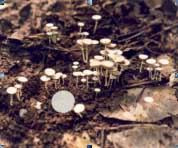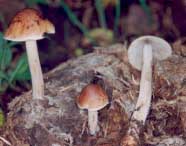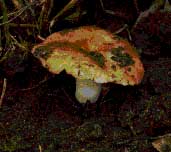
KUMARESAN. V.
Indian Institute of Science,
Bangalore 560012, India
Present Address:
Department of Botany Tagore Arts College
Lawspet, Pondicherry - 605 008.
|
Mushrooms: Their
Diversity and role in Ecosystem |
 KUMARESAN. V. |
Centre
for Ecological Sciences, Indian Institute of Science, Bangalore 560012, India Present Address: Department of Botany Tagore Arts College Lawspet, Pondicherry - 605 008. |
| Back |
Mushrooms
belong to the class Basidiomycetes of Kingdom Mycota (Fungi).
Their fruiting bodies occur as small umbrella-like structures in the surrounding
environment generally during rainy season. They vary much in shape, size and
colour; some of them are edible and some proven to be inedible/poisonous (referred
to as toadstools). Mushrooms play a very important role in ecosystem functioning.
This article reports about mushrooms with gills or lamellae.
| Occurrence, distribution and diversity |
Mushrooms attract even a layman, who has hitherto no knowledge about fungi,
due to its attractive morphology. They occur in soil, humus, plant litter,
herbivore dung and termite hill and also on living plants. Most of the mushrooms
are 'cosmopolitan' occurring both in tropical and temperate regions, of course
some of them like Lentinus are more confined to tropical and subtropical
regions and some like Hygrophorus to the temperate region (Singer 1986).
Pegler (1977) studied the agaric diversity of East Africa and described the
affinities of different species to different forest types. The studies on mushrooms
are mainly aimed at describing them and validating its status as new record
or species new to science, but, there are relatively a few studies that have
been done to understand the ecology of this group of fungi mainly due to short
life span (of their fruiting bodies).
 |
 |
 |
Fig.
1. Mushrooms growing on different substrates. (from left to right) Pleurotus
sp. growing on wood log,
Micropsalliota sp. growing on soil among leaf litter, Panaeolus
on elephant dung.
Campoamor and Molina (2001) showed that the main ecological factor affecting Tricholomataceae distribution in Mediterranean region was climate which had more influence than lithology and the greatest richness and diversity of Tricholomataceae is attained in cool sub-humid climates. Some dominant genera recorded by them include Clitocybe, Collybia, Laccaria, Mycena, Tricholoma etc. A survey of Swiss forest plot (1500 sqm) for over a period of 21 years yielded more than 400 species of mushrooms and fruit body production was correlated with the precipitation and temperature (Straatsma et al 2001). A preliminary study carried out in dry thorn forest, dry deciduous forest, moist deciduous forest and semi-evergreen forest in Mudumalai Wildlife Sanctuary and stunted montane evergreen forest in the Nilgiris (in Western Ghats) resulted in the identification of 61 genera of mushrooms. The survey covered an area of 4800 sqm in each forest type. The identification process to the species level is still in progress. A comparative study was done for dry thorn forest and dry deciduous forest with sampling area of 3200 sqm (with 32 equal subplots) in each of the forest types with sampling done thrice. The results showed that there was very little overlap between the mushroom species assemblages of the two forest types (Jaccard's similarity coefficient = 3.8%). Members of Tricholomataceae and Agaricaceae were dominant. Some of the dominant genera were Agaricus, Crinipellis, Lepiota, Micropsalliota and Marasmiellus. Also, the saturation with respect to number of species in both of the forest types was not reached as the area increased (Figs. 2 and 3), suggesting that intensive sampling for mushrooms over larger areas seems to be needed for understanding the species-area relationship.


As decomposers: Mushrooms fruiting bodies are formed only when conditions are favorable but their mycelium exist below ground, in plant litter etc., inconspicuously for a very long time. Most of them are saprophytic and constitute major recyclers of nutrients. They are known to break down lignocelluloses and thus help in litter degradation (Tanesaka et al., 1993; Miyamoto et al., 2000; Osono and Takeda, 2002), converting large molecular complexes into simpler compounds. This is exemplified by species belonging to the mushroom genera including Crinipellis, Lentinus, Marasmiellus, Marasmius, Mycena, Pleurotus etc. The activities of these fungi aid in the return of carbon, hydrogen, nitrogen, and minerals back into the ecosystem to be utilized by plants and other organisms. These genera of mushrooms are almost cosmopolitan occurring in tropical and temperate regions. Mushrooms also grow in polluted environments and can absorb toxins directly into their tissues, especially heavy metals (Bressa et al. 1988; Stijve 1992). Therefore the contaminated soils need not be transported to long distances and bioremediation of toxic waste is possible in situ eliminating the expenses for transportation, and storage.
 |
 |
 |
Fig
4. Crinipellis sp. Fig 5. Lentinus sp. Fig. 6. Leucocoprinus
cepaestipes
(Mushrooms growing on non-living plant parts in different forest types in MWLS)
Ectomycorrhizal (EM) associations: Ectomycorrhizal fungi account
for around 30% of the known fleshy fungi including gilled-fungi worldwide. It
is a well known fact that this symbiotic association helps in the uptake of
poorly mobile nutrients including nitrogen and phosphorous by plants in nutrient
poor soils. Dominant trees in most of the world's temperate and boreal forests
in tropical and subtropical regions are ectomycorrhizal (Allen 1991; Read 1991).
Three percent of vascular plants worldwide form EM association with the roots
of higher plants. Even though this percentage is low, the EM tree species occupy
extensive areas of forest (Borbour and Billing, 2000). Amanita, Boletus,
Cortinarius, Laccaria, Lactarius, Russula etc. are known to form EM association
with roots of higher plants (summarized in Smith and Read, 1997).
Indian context: Occurrence of ectomycorrhizal fungi is well documented in the
north western Himalayas in India (Atri et al. 1994; Lakhanpal 1996; Rawla and
Sarwal 1983). These include species of Russula, Lactarius, Boletus etc.,
associated with members of Coniferales, Fagales, Salicales etc. There
are relatively a few reports from southern India and are confined to Western
Ghats region. Russula parazurea has been reported from the Nilgiris (Natarajan
and Raman, 1983), Anamika indica is reported to be ectomycorrhizal with
Hopea trees in Kerala (Thomas et al. 2002) and a survey of Uppangala forest
in Karnataka revealed the presence of some ectomycorrhizal forms including species
of Russula, Boletus, Amanita and Cortinarius associated with Dipterocarpaceae
(Senthilarasu et al. 2004). Besides this, anatomical studies of ectomycorrhizas
of Pinus that are formed by Amanita muscaria and Laccaria laccata,
in the Nilgiris have also been done (Mohan et al. 1993). Survey for ectomycorrhizal
fungi in dry deciduous forest in Mudumalai Wildlife Sanctuary in the Nilgiris
showed that 2 species of Russula (Fig. 8) were constantly associated
with Shorea roxburghii.
Fig. 7 Amanita muscaria associated with Pine in the Nilgiris and (right) the morphology of ectomycorrhizal root of Pine |
 Fig. 8 Russula sp. |
Presently
the studies on ectomycorrhizal associations have gone beyond the morphological
and anatomical approach and modern molecular tools are being used. This tool
has proven very useful keeping in mind that the fruiting structures which are
indicators of associations in traditional methods are not always found and study
of vegetative stages that occur throughout by suitable molecular technique.
Most of the molecular techniques use the polymerase chain reactions followed
by RFLP (Restriction Fragment Length Polymorphism) or sequencing of the amplified
region. The primary amplification targets have been ribosomal genes and spacers
(internal transcribed spacers); these regions have high copy number, highly
conserved sequence tracks that serve as sites for primer design, and regions
that are variable between the primer sites (Horton and Bruns, 2001). Also, primers
have been designed to identify the fungal components in the roots with ectomycorrhizal
associations (Gardes and Bruns 1993). Bruns et al. (1998) have created a sequence
database for the identification of ectomycorrhizal basidiomycetes for ML5-ML6
region of the mitochondrial large subunit.
| Biotechnological Potential |
Fungi not only play a vital role in ecosystem functioning but some of them are
also useful in the production of bioactive compounds including industrially
important enzymes. There are more than 72,000 spp. of fungi described so far
and only a few of them have been brought into pure culture. A vast majority
of the latter are common ubiquitous moulds like Aspergilli, Penicillia, Fusaria
etc. (in Subramanian, 1992). Presently there are many efforts to culture unusual
fungal species. Some of the well-known secondary metabolites of fungi that have
proved to be a boon to humanity include Penicillin from Penicillium chrysogenum,
griseofulvin from P. griseofulvum, cephalosporin form Cephalosporium
etc. Ganoderma, basidiomycetous fungi, is now being extensively studied
for its potential in pharmaceutical industry. Chihara et al. (1969) isolated
Lentinan a water-soluble polysaccharide from Lentinus edodes that prevents
tumour development in mice. Schizophyllan from Schizophyllum sp. is effective
against cervical cancer (Mizuno 1996). Also, a number of immunity-enhancing,
anticancer and antitumour fractions were isolated from Agaricus blazei (Mizuno
et al. 1990). Besides their usefulness in pharmaceutical industries it is a
well know fact that they are also important component in food industries, best
examples being Agaricus bisporus (Button Mushroom), Pleurotus ostreatus
(Oyster Mushroom).
| Opinion |
Kirk et al. (2001) in the latest dictionary of fungi include 9387 species in
347 genera belonging to 26 families in the order Agaricales (gilled-fungi belong
to this order). But, lot of them is yet to be described, keeping in mind Hawksworth's
(1991) contention that 1.5 million fungi (only approx. 72,000 species have been
described) could exist. This is especially true for Western Ghats which has
vast expanse of forest cover with varied climatic factors and diverse flora
and fauna. Also, ectomycorrhizal forms need to be identified which form symbiotic
associations as mentioned above. Their identification will be useful in forest
management programmes; some associations are in fact obligatory. Further, systematic
sampling of mushrooms would also enlighten more on their ecology. Culturing
as many of them as possible and bringing them into pure culture will give us
the raw material to work on their biotechnological potential.
| Acknowledgments |
The work carried out in MWLS and stunted montane forest in Nilgiris was carried out with the help of funding provided by Department of Biotechnology, Government of India. I thank Prof. R. Sukumar, CES, IISc. for supporting me in carrying out this work and Prof K, Natarajan, University of Madras for encouraging to take up the study on mushrooms.